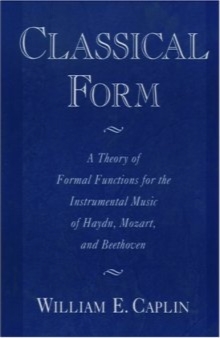فرم کلاسیک : نظریه توابع رسمی برای موسیقی بی کلام از هایدن ، موتزارت و بتهوون Classical Form: A Theory of Formal Functions for the Instrumental Music of Haydn, Mozart, and Beethoven
- نوع فایل : کتاب
- زبان : انگلیسی
- نویسنده : William E. Caplin
- ناشر : Oxford University Press, USA
- چاپ و سال / کشور: 1998
- شابک / ISBN : 0195104803, 9780195104806, 9781423759218
Description
For anyone interested in the music of the Viennese Classicism, this book is a godsend. It basically follows a two-part plan: (1) Teach a new, highly detailed sonata construction terminology, from the smallest parts to parts of whole movements and (2) show how these interrelate most of the time, and why certain instances break the supposed norms (based on the styles of Haydn, Mozart and Beethoven, which are very much alike and MOSTLY complimentary). It starts with showing how various types of opening phrases are built, and how these relate and differ to later phrases or themes introduced (all the various kinds are gone through thoroughly). This then leads into a discussion of the nature of the development and recapitulation, and ends up discussing each of the normal "sonata-style" movement forms separately. I think this is a wonderful book both for musicologists and would-be composers (you'll probably need to develop your own exercises on the way, but when you are ready to deal with a book like this, you should handle that). It can probably be read by the enlightened dilettante, but unless you are willing to spend the amount of time needed to recognize each element while listening, I think the book is most useful for people who are actually working with music on paper. Performers who are not put off by theoretical discussions could probably benefit from it as well. The book uses functional harmonic theory in the vein of Schönberg and Riemann. In my native Norway this method is a lot more widely used than Schenkerian analysis, so I haven't had any problems with it; I've understood that some American readers may have to spend a little time adapting, though. My only gripe with the book is that the terminological material presented is vast and, while I am in no position to suggest improvements, feels like it could have been simplified. This is a minor inconvenience, but the rewards of the book are so great that it's definitely worth the time to go through it that extra time just to get it all down. Any other caveats? There's two, both minor ones. First of all, all referential notes are printed in the back of the book. I usually like to read all of these, so I prefer that they are printed on the page where they are relevant; Saves me a lot of page flipping. The other point is that this book leaves out a large part of sonata theory: Texture. Although some very general observations are made, such as the fact that Alberti Bass and similar procedures usually are first introduced in transition passages (p. 125), texture isn't mentioned much. This book is primarily about melody and it's harmonic foundation. Which, of course, is fine. For what it is, it is a wonderful book, and one would be deluded to think that you could cram everything there is to know about sonata theory into 250 pages. For the interested reader I'd also like to add Charles Rosen's Sonata Forms as a complimentary read: While this is a book very focused on terminology and isolation and fragmentation of sonata elements, Rosen's book take a much more prosaic road, in the vein of sir Donald Francis Tovey. I am just about to start on Hepokosky/Darcy's book Elements of Sonata Theory; Hopefully I will soon be able to add it to my recommended list. However, I have to withhold one star. Why? Before I bought the book from Amazon, I borrowed it from the library. Comparing the two versions, the newer versions have significantly worse print quality than the older prints. The font is thicker, heavier and slightly less pleasing, but this isn't much of a problem. What IS annoying though is the quality of the note examples. I don't want to believe it, but it honestly look like OUP decided they needed to reprint this book, but had lost the original digital version, so they simply photocopied an earlier book and copied the scans. Both the stems and the bar lines are of varying thickness, and sometimes look slightly bent, and the whole score looks more blurred, and harder on the eye. I don't know why it came to be that way, but it appears totally meaningless, since the earlier print looked perfect. As far as I can see there's been no changes whatsoever in content.


